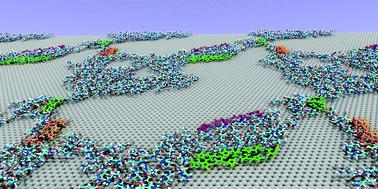Our official English website, www.x-mol.net, welcomes your feedback! (Note: you will need to create a separate account there.)
Side-chain effects on the co-existence of emergent nanopatterns in amino acid adlayers on graphene.
Nanoscale ( IF 6.7 ) Pub Date : 2020-06-15 , DOI: 10.1039/d0nr01333a Joel B Awuah 1 , Tiffany R Walsh
Nanoscale ( IF 6.7 ) Pub Date : 2020-06-15 , DOI: 10.1039/d0nr01333a Joel B Awuah 1 , Tiffany R Walsh
Affiliation

|
The spontaneous tendency of amino acid adlayers to self-assemble into ordered patterns on non-reactive surfaces is thought to be chiefly influenced by amino acid termination state. Experiments have shown that different side chains can produce different patterns, with a distinction drawn between side chains that can support hydrogen bonds or electrostatic interactions, and those that are hydrophobic. However, as is demonstrated in this work, this distinction is not clear cut, implying that there is currently no way to predict in advance what type of pattern will be formed. Here, we use molecular dynamics simulations of amino acid adlayers in neutral, zwitterion, and neutral-zwitterion states for two types of amino acids, either histidine or alanine, adsorbed at the in-vacuo graphene interface. In contrast to earlier studies on adlayers of tryptophan and methionine on graphene that reveal the presence of only a single type of pattern motif, the canonical dimer row, here we find that emergent patterns of histidine and alanine adlayers supported the co-existence of several different types of motifs, influenced by the different side-chain characteristics. For alanine, the compact side-chain does not support hydrogen bonding and engages weakly with the surface, leading to the emergence of a new dimer row configuration in addition to the canonical dimer row motif. On the contrary, for histidine, the side-chain supports hydrogen bonding, leading to the emergence of a dimer row motif different from the canonical dimer row, co-existing with several different monomer row motifs. On this basis, we propose that emergent canonical dimer row patterns are more likely for amino acids with side-chains that are non-compact and that also lack extensive hydrogen bonding capacity, and that engage strongly with the underlying substrate. These findings provide a fundamental basis to rationally guide the design of desired self-assembled nanostructures on planar surfaces.
中文翻译:

侧链对石墨烯氨基酸层中突现的纳米图案共存的影响。
认为氨基酸加成物在非反应性表面上自组装成有序图案的自发趋势主要受氨基酸终止状态的影响。实验表明,不同的侧链可以产生不同的模式,可以支撑氢键或静电相互作用的侧链与疏水性侧链之间存在区别。但是,正如这项工作所证明的,这种区别尚不明确,这意味着目前尚无办法预先预测将形成哪种类型的图案。在这里,我们使用分子动力学模拟氨基酸吸附剂在中性,两性离子和中性两性离子状态下吸附在真空中的两种类型的氨基酸(组氨酸或丙氨酸)石墨烯界面。与早期对石墨烯上色氨酸和蛋氨酸的附加剂的研究相反,该研究揭示了仅存在一种类型的图案基序,即规范的二聚体行,在这里我们发现组氨酸和丙氨酸附加剂的新兴图案支持多种不同形式的共存受不同侧链特性影响的主题类型。对于丙氨酸,紧密的侧链不支持氢键,并且与表面的结合较弱,因此,除了规范的二聚体行基序以外,还出现了新的二聚体行构型。相反,对于组氨酸,侧链支持氢键,导致与典型的二聚体排不同的二聚体排基序出现,并与几种不同的单体排基序共存。在此基础上,我们提出,具有非紧密侧链且缺乏广泛的氢键结合能力且与下层底物紧密结合的氨基酸的氨基酸,更有可能出现典型的二聚体行模式。这些发现为合理指导平面上所需的自组装纳米结构的设计提供了基础。
更新日期:2020-07-02
中文翻译:

侧链对石墨烯氨基酸层中突现的纳米图案共存的影响。
认为氨基酸加成物在非反应性表面上自组装成有序图案的自发趋势主要受氨基酸终止状态的影响。实验表明,不同的侧链可以产生不同的模式,可以支撑氢键或静电相互作用的侧链与疏水性侧链之间存在区别。但是,正如这项工作所证明的,这种区别尚不明确,这意味着目前尚无办法预先预测将形成哪种类型的图案。在这里,我们使用分子动力学模拟氨基酸吸附剂在中性,两性离子和中性两性离子状态下吸附在真空中的两种类型的氨基酸(组氨酸或丙氨酸)石墨烯界面。与早期对石墨烯上色氨酸和蛋氨酸的附加剂的研究相反,该研究揭示了仅存在一种类型的图案基序,即规范的二聚体行,在这里我们发现组氨酸和丙氨酸附加剂的新兴图案支持多种不同形式的共存受不同侧链特性影响的主题类型。对于丙氨酸,紧密的侧链不支持氢键,并且与表面的结合较弱,因此,除了规范的二聚体行基序以外,还出现了新的二聚体行构型。相反,对于组氨酸,侧链支持氢键,导致与典型的二聚体排不同的二聚体排基序出现,并与几种不同的单体排基序共存。在此基础上,我们提出,具有非紧密侧链且缺乏广泛的氢键结合能力且与下层底物紧密结合的氨基酸的氨基酸,更有可能出现典型的二聚体行模式。这些发现为合理指导平面上所需的自组装纳米结构的设计提供了基础。


























 京公网安备 11010802027423号
京公网安备 11010802027423号